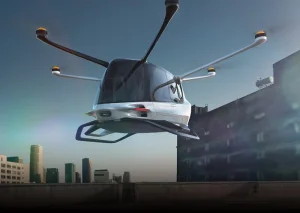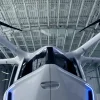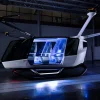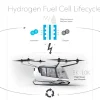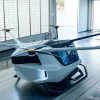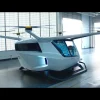- Directory
- Evtol | Electric Aircraft
- Hydrogen/Electric eVTOL
- Alaka'i Skai
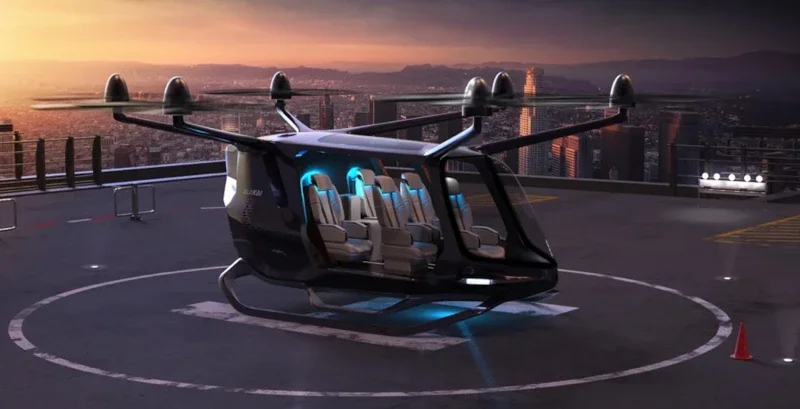
Alaka'i Skai is a hydrogen eVTOL aircraft
719 1 10 0
Operational Information
Overview:
Alaka'i Skai is a hydrogen eVTOL (Electric Vertical Takeoff and Landing) aircraft that emphasizes a blend of simplicity, safety, and environmental sustainability. This aircraft is designed to offer a clean, efficient mode of air mobility. It can accommodate up to five people and achieve flights up to four hours with a quick refueling time of less than 10 minutes. It leverages hydrogen fuel cells for power, making it a zero-emission vehicle, with water as its only byproduct.
Aircraft type:
Aircraft Model
Skai
Manufacturer
Alaka'i
Crew
- Autonomous
- Piloted
Propulsion
- Electric Multicopter
Enter service date.
2026
Website
https://www.alakai.com/
Performance and Capacity
Propellers:
- 6 propellers
Power source:
- Liquid Hydrogen
Passenger Capacity
4
Range
10 and 150 miles.
Maximum Range
NA
Cruise speed
NA
Maximum Speed
115 mph
Cruise altitude
NA
Maximum Altitude
NA
Noise at hover
NA
Noise at cruise
NA
Time to recharge
10 minutes
Maximum Takeoff Weight
NA
Aircraft Design and Dimensions
Height
NA
Width
NA
Lenght:
NA
Wingspan
NA
Cabin lenght
NA
Cabin height
NA
Cabin width
NA
Alaka'i Skai is a hydrogen eVTOL (Electric Vertical Takeoff and Landing) aircraft emphasizing simplicity, safety, and environmental sustainability. This aircraft is designed to offer a clean, efficient mode of air mobility. It can accommodate up to five people and achieve flights up to four hours with a quick refueling time of less than 10 minutes. It leverages hydrogen fuel cells for power, making it a zero-emission vehicle, with water as its only byproduct.
Development:
Developed by Alaka’i Technologies, the Skai eVTOL utilizes hydrogen fuel cells, setting it apart as a leader in sustainable aviation technology. The company collaborates with Designworks, a BMW Group company, to enhance the aircraft’s design and passenger experience, prioritizing safety, comfort, and performance.
Performance and Capabilities:
Skai has six rotors and a sophisticated fly-by-wire system, ensuring stability and reliability. It boasts a range of up to 400 miles and a flight duration of about four hours. The aircraft can accommodate one pilot and four passengers, with a significant focus on safety through redundancies such as multiple hydrogen leak detectors and a fail-safe parachute system.
Here are the key specifications:
- Power Source: The Skai is powered by hydrogen fuel cells, which provide a clean and efficient energy source with water as the only emission.
- Range and Duration: It can fly for about four hours or cover a distance of up to 400 miles on a single refuel, offering substantial range for an eVTOL.
- Passenger Capacity: Designed to accommodate one pilot and up to four passengers, making it suitable for small group travel.
- Safety Features: Equipped with multiple redundant systems for enhanced safety, including hydrogen leak detectors and a fail-safe parachute system that can deploy in the event of multiple system failures.
- Design: Collaboratively designed with Designworks, a BMW Group company, focusing on a balance of aesthetics, comfort, and functionality. The aircraft features a streamlined, modern cabin with premium materials and large windows for panoramic views.
- Operational Capabilities: Skai is designed for vertical takeoff and landing (VTOL), allowing it to operate in diverse environments with minimal need for runway infrastructure.
- Environmental Impact: As a hydrogen-powered aircraft, Skai supports environmental sustainability by reducing pollution and reliance on fossil fuels.
- Infrastructure Requirements: Skai’s operation requires minimal infrastructure, and it can be refueled in less than 10 minutes using smart pumps, enhancing its viability for various operational contexts.
Market Competition and Applications:
Skai is positioned to compete in the growing eVTOL market by offering multiple configurations tailored to different needs, including air-taxi services (SkaiCab), EMS and medivac services (SkaiMed), luxury business travel (SkaiCraft), and cargo transport (SkaiCargo). These options demonstrate its versatility and potential to cater to a broad range of urban and regional air mobility requirements.
The Alaka’i Skai faces competition from several innovative designs, notably the Sirius Jet and the Lilium Jet.
Sirius Jet:
Developed by Sirius Aviation, the Sirius Jet is another hydrogen-powered eVTOL aircraft that emphasizes extended range and speed. It boasts a range of up to 1,150 miles, achieved through a hydrogen-electric propulsion system. The Sirius Jet is designed to accommodate up to three passengers in its business variant and up to five in the commercial version, making it versatile for both private and commercial uses. Its design features include pressurized cabins, high-speed capabilities (reaching speeds of up to 323 mph), and significant noise reduction measures.
Lilium Jet:
Lilium, a competitor in the eVTOL market, offers the Lilium Jet, which uses electric jet engines to achieve vertical takeoff and landing. The Lilium Jet focuses on sustainability with a quieter, battery-powered operation and targets a shorter range than hydrogen-powered models like Sirius Jet and Alaka’i Skai. It is designed primarily for regional transportation, providing a different approach to the urban and regional air mobility market.
Both aircraft represent the broader trend in the aviation industry toward developing sustainable, efficient, and flexible urban air mobility solutions. With its extended range and speed, the Sirius Jet presents a direct challenge to the Skai, particularly in scenarios where longer distance travel is necessary. Meanwhile, the Lilium Jet’s use of electric propulsion offers an alternative for operators prioritizing short-haul, frequent routes with minimal environmental impact. Each model’s unique features cater to different segments of the burgeoning eVTOL market, showcasing the diverse approaches to solving urban transportation challenges.
Development Progress and Future Outlook:
Alaka’i Technologies is advancing towards the commercial launch of Skai, emphasizing its potential to reduce urban congestion, enhance transportation efficiency, and contribute to environmental sustainability. The company’s approach to using hydrogen, a clean energy source, aligns with broader goals of reducing the aviation industry’s carbon footprint .
Conclusion:
Alaka’i Skai stands out in the eVTOL industry for its innovative use of hydrogen fuel cells and its commitment to safety, design excellence, and application versatility. As the technology matures and infrastructure develops, Skai could significantly impact how we think about and utilize urban air mobility.
FAQ Section for Alaka'i Skai
What is Alaka'i Skai?
Alaka’i Skai is a hydrogen-powered electric vertical takeoff and landing (eVTOL) aircraft designed by Alaka’i Technologies. It aims to offer a clean, efficient, and safe transportation solution for urban and regional travel.
How does the Alaka’i Skai operate on hydrogen fuel?
Skai uses hydrogen fuel cells, providing an energy-efficient solution with water as the only emission. This technology supports a cleaner environment and allows the aircraft to have a range of up to 400 miles with about four hours of flight time.
The Alaka’i Skai utilizes hydrogen power due to its high energy efficiency and environmental benefits. Hydrogen fuel cells generate electricity through a chemical reaction between hydrogen and oxygen, with water being the only emission. This makes the Skai a zero-emission aircraft, contributing to cleaner air and less environmental impact than traditional fossil fuels. Additionally, hydrogen can be produced from various renewable sources, aligning with sustainable energy goals. Hydrogen also allows for longer flight ranges and quick refueling times, enhancing the practicality and efficiency of the Skai for urban and regional air mobility.
What are the safety features of the Alaka’i Skai?
Skai has multiple safety features, including redundant systems and hydrogen leak detectors. In case of multiple system failures, an airframe-mounted parachute can deploy to land the aircraft safely. The design also includes impact-absorbing seats and advanced avionics for safe operations.
Who designed the Alaka’i Skai, and what was the focus of its design?
The design of Skai was a collaboration with Designworks, a BMW Group innovation studio. The focus was on creating a balance of safety, passenger experience, and performance, ensuring a stable and efficient ride.
Can the Alaka’i Skai be used for different types of services?
Yes, Skai offers versatile configurations for different services:
- SkaiCab: An air taxi service providing urban and regional travel for up to five passengers.
- SkaiMed: An EMS and medivac service designed to reach patients in hard-to-access areas quickly.
- SkaiCraft: A luxury business travel option with a high-end cabin experience.
- SkaiCargo: A cargo service capable of transporting up to 1000 lbs of goods.
What makes Alaka’i Skai a viable option for urban air mobility?
Skai’s design requires minimal infrastructure, enabling takeoff and landing from virtually anywhere, like rooftops or parking lots. This flexibility and its eco-friendly hydrogen power position Skai as a sustainable choice for reducing urban congestion and enhancing transportation efficiency.
Where can I learn more about Alaka’i Skai and possibly book a flight?
For more detailed information and updates on booking and service availability, you can visit Alaka’i Technologies’ official website at Alaka’i Skai.

